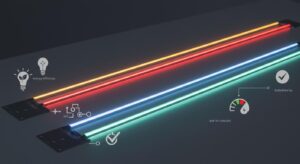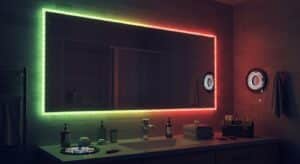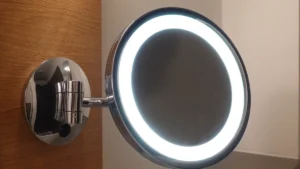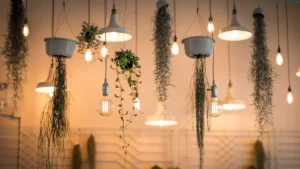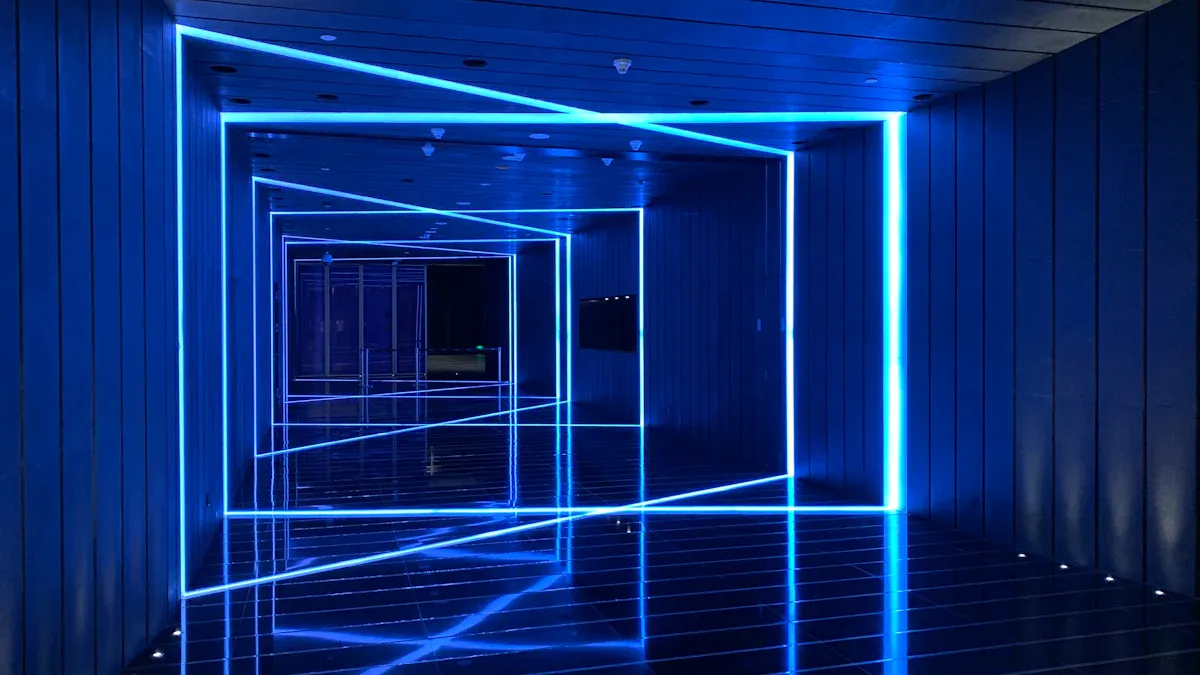
LED light strips are thin and bendable circuits with small lights. You can use them to make bright and energy-saving lighting. Their small size lets you put them in tight spots. This makes them great for modern lighting ideas.
Today, LED strips are important for changing how we light spaces. They use only 10-30% of the energy of old-style lights. They are just as bright but last much longer. They can work up to 25 times longer than regular bulbs. This means less fixing and more money saved. Many strips have smart controls to change brightness automatically. This helps save even more energy.
Key Takeaways
LED light strips use less energy than regular bulbs. They save money on electricity bills.
These strips last much longer than normal bulbs. They can work for 50,000 to 200,000 hours. This means fewer replacements are needed.
LED strips are flexible and work in many places. You can use them at home, in offices, or outside for cool lighting ideas.
When picking LED strips, think about how bright they are. Also, check the color, dimming options, and smart controls to fit your needs.
Installing and taking care of LED strips helps them last longer. This makes sure you get the best value for your money.
What Are LED Light Strips?
Definition and parts of LED light strips
LED light strips are bendable boards with tiny LEDs. They give bright and energy-saving light for many uses. These strips often come in rolls and can be cut to size. Most have sticky backs, making them easy to stick anywhere.
The main parts of an LED light strip are:
LED Emitters: Small lights that shine brightly. Types include SMD and COB, each with special features.
Circuit Board: A board, either soft or hard, that holds the LEDs and connects them.
Power Supply: These strips use low-voltage power, like 12V or 24V, which is safe and saves energy.
Resistors: These control the electricity so the LEDs don’t get damaged.
Protective Coating: Some strips have covers to keep out water or dust, making them last longer.
Most LED strips are about half an inch wide and have 18-36 LEDs per foot. Good-quality strips often use copper boards with shiny coatings to make the light brighter.
How LED strip lights work
LED strips work using a process called electroluminescence. When electricity flows, the LEDs light up. The color depends on the material inside the LEDs.
Here’s how they work step by step:
Power Supply: Plug the strip into a low-voltage power source.
Current Flow: Electricity moves through the board to each LED.
Light Emission: The LEDs turn electricity into light with little heat.
Control Mechanism: Many strips let you change brightness, colors, or patterns. Some even work with smart home systems.
LED strips are made to save energy and last a long time. For example, COB strips use tightly packed chips for smooth, bright light without gaps.
Special features of LED technology
LEDs have many benefits over old-style lights. These features make them great for homes and businesses:
Energy Efficiency: LEDs use much less power than regular bulbs, saving money.
Durability: They are tough and can handle shocks or bad weather.
Longevity: LED strips can last 25,000 to 200,000 hours, much longer than old bulbs.
Customizability: You can bend them and pick colors like RGB or RGBW for cool effects.
Eco-Friendliness: Many are made from eco-friendly materials and can be recycled.
New technology has made LED strips even better. Smart systems let you control them with phones or connect to smart devices. Better heat control and waterproofing make them last longer, even outdoors.
Tip: When picking an LED strip, think about brightness, color, and power needs to find the right one for you.
Benefits of LED Strip Lights
Energy efficiency and cost-effectiveness
LED strip lights are very energy-saving. They use up to 90% less power than old incandescent or fluorescent bulbs. This means you get bright light while paying less for electricity. For example, lighting makes up 17% of electricity use in U.S. commercial buildings. Switching to LEDs can save a lot of money. Plus, LEDs give off less heat, making them safer and more efficient.
LED strips also save money in other ways. They last 50,000 to 100,000 hours, which is about 25 times longer than regular bulbs and four times longer than CFLs. While LEDs may cost more at first, they last longer and need less fixing. This makes them a smart choice for the future.
Metric | Светодиодные посадочные огни | Conventional Lighting |
|---|---|---|
Power Consumption | 90% less power usage | Higher power usage |
Longevity | Longer lifespan | Shorter lifespan |
Heat Production | Lower heat output | Higher heat output |
Luminous Efficiency | Higher lumens per watt | Lower lumens per watt |
Tip: Choose LED strip lights to save money and energy without losing brightness.
Versatility in design and applications
LED strips are super flexible and work in many places. You can bend them to fit small spaces or create cool lighting effects. Whether you want to make your home cozy or your office modern, LED strips can do it.
Here are some common ways to use LED strips:
Accent lighting to show off special features.
Gaming rooms or home theaters for fun lighting.
Art displays to light up paintings or sculptures.
Event lighting for exciting atmospheres.
Bright signs with changing colors for businesses.
Pathway and stair lighting for safety.
Outdoor lighting for patios and gardens.
Holiday decorations for festive looks.
Car lighting for style and better visibility.
Mood lighting for health and relaxation.
This flexibility makes LED strips popular for homes and businesses.
Durability and long lifespan
LED strip lights are made to last a long time. They can shine for about 50,000 hours. That’s over 13 years if you use them 10 hours daily. Unlike old bulbs that stop working suddenly, LEDs slowly get dimmer. This helps you plan replacements easily.
The L70 rule means that after 50,000 hours, LEDs still shine at least 70% as bright as before. This slow dimming gives steady light for years. Also, LED strips can handle shocks, vibrations, and bad weather. This makes them great for both indoor and outdoor use.
Note: Using LED strip lights gives you reliable lighting for years and saves you money on replacements.
Types of LED Strip Lights
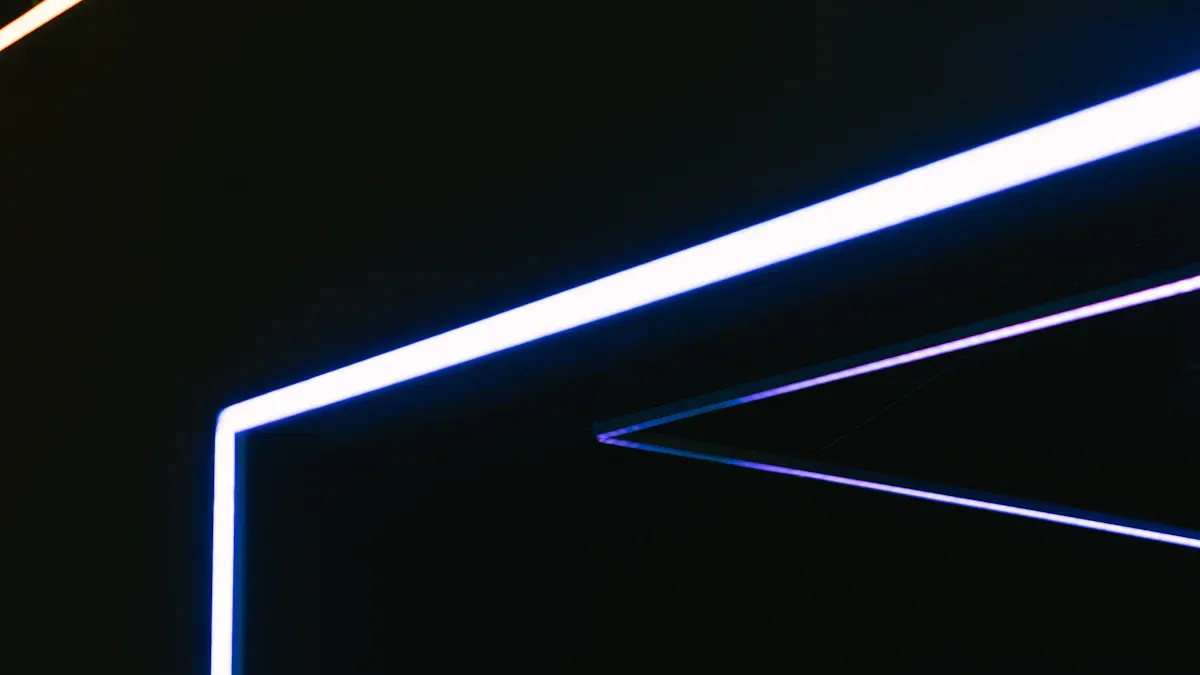
LED strip lights come in different types for various needs. Knowing these types helps you pick the right one.
Flexible vs. Rigid LED Strips
Flexible LED strips are popular and easy to use. They have bendable boards, perfect for curved or tight spaces. Use them under cabinets, on stairs, or around corners. Their flexibility makes them great for creative designs like accents or decorations.
Rigid LED strips are fixed on solid boards that don’t bend. They are stronger and handle heat better. These strips are good for straight-line setups like display cases or industrial lighting. While less flexible, they are durable for long-term use.
Tip: Use flexible strips for creative ideas and rigid ones for sturdy setups.
Single-Color, RGB, and RGBW Options
LED strips come in single-color, RGB, and RGBW types. Single-color strips give one steady color, like warm or cool white. They’re great for tasks or setting a mood.
RGB strips mix red, green, and blue lights to make many colors. You can change colors with a controller, making them fun for parties or gaming rooms. RGBW strips add a white light for more natural brightness. This makes them useful for both colorful and practical lighting.
LED Type | Brightness (Lx) | Improvement (%) |
|---|---|---|
Chinese RGB LEDs | 177 | N/A |
MASTER RGB LEDs | 859 | 385 |
Chinese RGB LEDs (White) | 265 | N/A |
MASTER RGB LEDs (White) | 1128 | 325 |
RGBW strips are perfect for spaces needing bright colors and white light, like living rooms or stores.
Note: RGBW strips are great for both fun and useful lighting.
Waterproof and Non-Waterproof LED Strips
Waterproof LED strips are made for wet or outdoor areas. They have coatings to protect against water and dust. The IP rating shows how much protection they offer. For example:
IP Rating | Description | Waterproof Capability |
|---|---|---|
IP65 | Resists water jets from any angle | Not for submersion |
IP67 | Handles short submersion (10 minutes) | Not for long submersion |
IP68 | Fully waterproof up to 3 meters | Good for underwater use |
Non-waterproof strips are lighter and easier to install. They work well indoors in dry places like bedrooms or offices.
For outdoor use, pick an IP rating of 65 or higher.
Higher IP ratings protect better in tough conditions.
Tip: Check the IP rating to ensure outdoor strips can handle wet areas.
Choosing the Right LED Light Strip
Key factors to consider (brightness, color temperature, etc.)
When picking an LED light strip, focus on brightness, color temperature, and color accuracy. Brightness, measured in lumens, shows how much light the strip gives off. Different uses need different brightness levels. For example:
прикладн | Suggested Lumen/Foot |
|---|---|
Accent/Mood lighting | 150-350 |
Under cabinet lighting | 175-525 |
Task lighting (close) | 275-450 |
Task lighting (far) | 350-700 |
Indirect lighting | 375-575 |
Fluorescent tube replacement | 500-950 |
Color temperature, measured in Kelvins, changes the feel of a space. Warm light (2700K-3000K) feels cozy, while cool light (5000K-6500K) works well for offices. The Color Rendering Index (CRI) is also important. A CRI above 80 shows colors clearly, which is great for makeup or art.
Tip: Pick a strip with adjustable brightness and color temperature for more options.
Matching LED strips to specific needs
Choosing the right LED strip helps it work better for your needs. Flexible RGB or RGBW strips are great for decoration. They let you pick colors and make fun effects. For work lighting, choose high-lumen strips with neutral white light (4000K). These give clear and bright light.
Look for features like LED density and dimming. More LEDs per meter give smoother light. Dimming lets you change brightness for different tasks. Smart features, like phone control, make it easy to adjust settings from anywhere.
Feature | Description |
|---|---|
Brightness | Higher lumens for brighter light. |
LED Density | More LEDs per meter for consistent glow. |
Color Control | Customizable colors for different moods. |
Dimming Capability | Adjustable brightness for various tasks. |
Smart Features | Remote control and smartphone integration for ease of use. |
Note: If you plan to use LED strips in large areas, check if they work with your power supply and controllers.
Budget and quality considerations
Finding the right balance between cost and quality is important. High-quality strips may cost more but last longer and work better. The LED market is growing fast because LEDs save energy and last a long time. They use about 50% less power than older lights, making them cheaper to run.
Cheaper LED strips are easy to find and install. They make your space look nice without needing top performance. But spending more on better strips gives brighter light, longer life, and extras like waterproofing or smart controls.
Tip: Compare options based on your needs and choose quality for long-term savings.
Installing LED Strip Lights
Tools and materials needed
Before you start, gather everything you’ll need. Being prepared makes the job easier and faster. Here’s a list of items:
LED strip lights
Power supply
Quick connectors or soldering tools
Scissors (to cut the strips)
Extra adhesive (if needed)
Alcohol wipes (to clean surfaces)
Zip ties (to hold wires in place)
Having these tools ready will save time and help your project look neat.
Step-by-step installation guide
Follow these simple steps to set up your LED lights:
Clean the surface: Wipe the area with alcohol wipes to remove dirt. This helps the strip stick better.
Measure and cut: Measure how much strip you need. Cut only at the marked lines to avoid damage.
Connect to power: Use quick connectors or soldering to link the strip to the power supply. Make sure the connection is tight.
Test the lights: Turn on the strip to check if it works evenly. Fix any problems before sticking it down.
Stick the strip: Remove the backing and press the strip onto the surface. Use extra adhesive if needed for better hold.
Place the power supply: Keep the power supply in a cool, open spot to stop it from overheating.
Check and tidy up: Look over everything and clean up your workspace.
Tip: Never turn on the strip while it’s rolled up. It can overheat and break.
Helpful tips to avoid mistakes
Always clean the surface first. Dust can make the strip fall off.
Keep the power supply in a ventilated area to avoid overheating.
Follow safety rules like the National Electric Code (NEC).
Use zip ties to keep wires neat and away from hot or moving parts.
Test the lights before sticking them down to save time later.
By following these steps and tips, you’ll have a safe and great-looking LED strip light setup.
Practical Applications of LED Light Strips
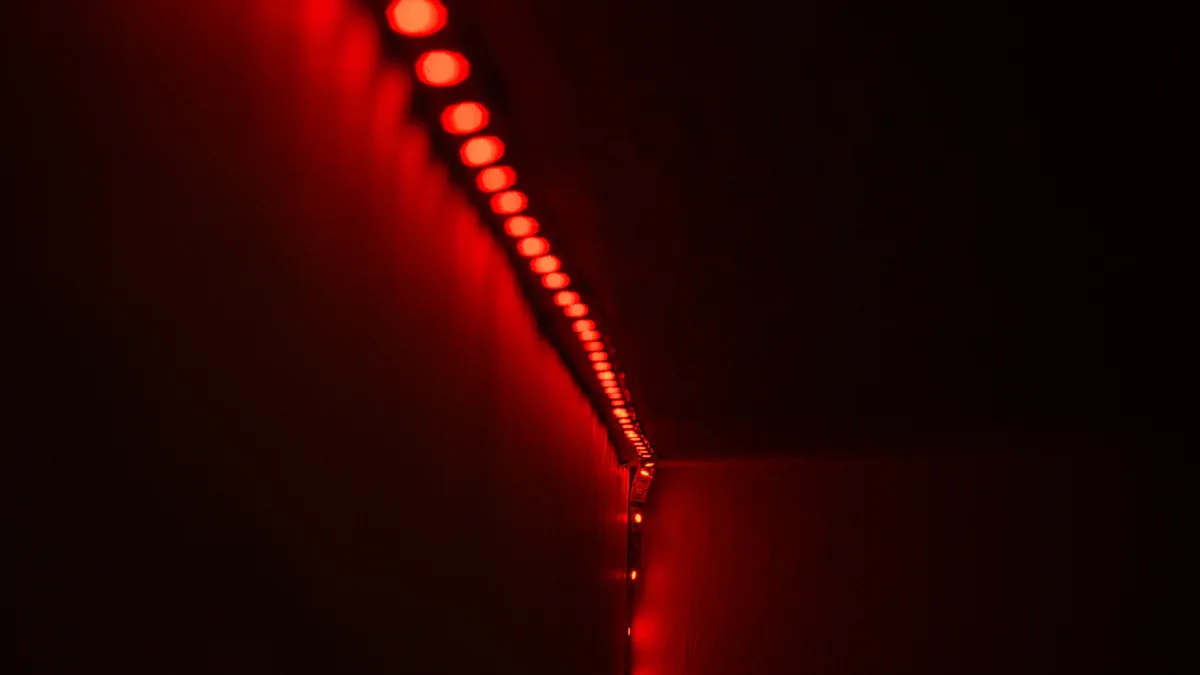
Home lighting solutions (kitchen, living room, bedroom, etc.)
LED light strips are great for making your home look better and brighter. You can use them in many rooms:
Kitchens: Place them under cabinets to light up counters. This makes cooking easier and gives your kitchen a modern style. They are strong and handle moisture well, perfect for kitchens.
Living Rooms: Add them around shelves, TVs, or ceilings for soft lighting. This makes the room feel warm and welcoming.
Bedrooms: Put them behind headboards or along floors for a calm and cozy feel.
Placing LED strips correctly avoids glare and shadows, giving even and beautiful lighting.
Commercial and retail lighting uses
LED strips are very helpful for businesses. They save energy and make stores look better. For example:
Lighting uses 17% of electricity in U.S. commercial spaces. Switching to LED strips can lower this a lot.
Stores using LED strips save up to 50% on energy. Adding smart controls can save another 20%.
LEDs are 10 times more efficient than halogen lights, cutting energy costs.
Use LED strips to brighten products, create cool displays, or improve store lighting. Their long life and efficiency make them a smart choice for businesses.
Outdoor and decorative lighting ideas
Outdoor LED strips are perfect for improving your outdoor areas. They use less energy, last longer, and make spaces safer and prettier. Here’s how they help:
Benefit | Description |
|---|---|
Energy Efficiency | Uses less power than older lighting options. |
Long Lifespan | Lasts much longer, so you replace them less often. |
Versatility | Works for gardens, pathways, and decks. |
Aesthetic Appeal | Makes outdoor spaces look nice while adding safety and charm. |
Use outdoor strips to light paths, show off garden features, or decorate patios. Their waterproof design keeps them working in any weather.
LED light strips are great for modern lighting needs. They use 75% less energy than regular bulbs. About 95% of their energy turns into light. This helps lower electricity bills and reduces CO2 pollution. They also need less fixing, saving money. You can use them in many ways, like for accents, under cabinets, or creative designs.
Application Type | Description |
|---|---|
Accent Lighting | Best for showing off special parts of a room. |
Under-Cabinet Lighting | Great for lighting up kitchen counters. |
Creative Applications | Bendable design makes cool lighting ideas possible. |
Try LED strips to make your spaces brighter, energy-saving, and unique.
FAQ
What are the best places to install LED strip lights in a home?
You can install LED strip lights under cabinets, along ceilings, or behind furniture. These areas create ambient or task lighting while enhancing the room’s design. For bedrooms, placing them behind headboards or under beds adds a cozy glow.
Tip: Use waterproof strips for kitchens or bathrooms to protect against moisture.
How do you choose the right brightness for LED strip lights?
Select brightness based on the purpose. Accent lighting needs 150-350 lumens per foot, while task lighting requires 350-700 lumens. For indirect lighting, aim for 375-575 lumens. Always check the lumens rating before buying.
Note: Higher lumens mean brighter lights, so match the brightness to your needs.
Can LED strip lights be cut and reconnected?
Yes, most LED strip lights can be cut at marked points. Use connectors or soldering tools to reconnect them. This feature allows you to customize the length for your specific project.
Warning: Cutting outside the marked lines can damage the strip and stop it from working.
Are LED strip lights safe for outdoor use?
Outdoor LED strip lights are safe if they have a waterproof rating of IP65 or higher. These strips resist water and dust, making them ideal for patios, pathways, or gardens. Always check the IP rating before installation.
Tip: Use IP68-rated strips for areas exposed to heavy rain or submersion.
How do you maintain LED strip lights?
Clean the strips regularly with a dry cloth to remove dust. Avoid using harsh chemicals. Check connections and power supplies periodically to ensure they work properly. Proper maintenance extends the lifespan of your lights.
Reminder: Keep the power supply in a ventilated area to prevent overheating.
See Also
Selecting The Perfect LED Strip Lights For Linear Lighting
Utilizing Smart LED Strips For Home Lighting Solutions 2025
Understanding COB LED Strips And Their Functionality
Comparative Analysis Of High-Brightness LED Strips For Use
Complete Guide To Choosing Outdoor LED Light Strips
